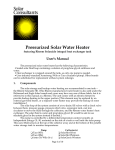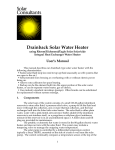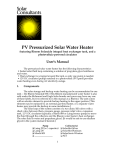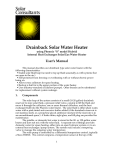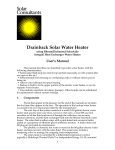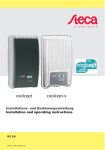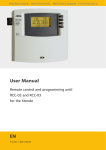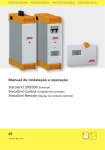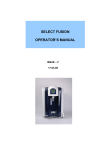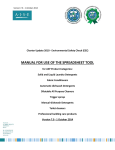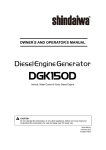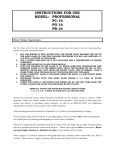Download Pressurized Solar Water Heater
Transcript
Pressurized Solar Water Heater
featuring Rheem Solaraide integral heat exchanger tank
User's Manual
The pressurized solar water heater has the following characteristics:
• Sealed solar fluid loop containing a solution of propylene glycol antifreeze
and water.
• Heat exchanger is wrapped around the tank, so only one pump is needed.
• Uses industry-standard Armstrong/Wilo or Taco circulator (pump). Other
brands can be substituted for replacement without system redesign.
1.
Components
The solar storage and backup water heating are accommodated in one
tank -- the Rheem Solaraide HE. (This Rheem-manufactured water heater is also
sold under the Richmond and Eagle Solar brands and yours may have any one
of those labels, but it is referred to in this manual as a Rheem.) The unit comes
with an electric element to provide backup heating to the upper portion. [This
element may be replaced by an external gas-fired heater, or a separate water
heater may provide the backup in some installations.]
The solar loop of the system consists of a two drain/fill valves with a
check valve between them, pressure gauge, pressure relief valve, expansion
tank, Armstrong Astro (or Wilo Star equivalent) or Taco cast iron circulator to
move the fluid through the collectors, and the Rheem water heater's heat
exchanger. The solar fluid is a solution of water and propylene glycol. [It would
be safe to use ethylene glycol in the system instead if desired.]
The pump is controlled by a differential temperature control, Steca
TR0301, mounted on the side of a tank or wall near the solar pump. The control
is connected to two sensors, one each at the top of the collector array and at the
bottom of the potable water storage tank to monitor temperatures.
Pump
Collector(s)
❏ Taco 007ci
❏ SolarHot Silver
❏ Taco 008ci
❏ SolarHot Platinum
❏ Astro 30/Wilo 16 ci
❏ SolarGenix Winston
1
Plumbing diagram of system with one collector,
using built-in electric element as backup.
2.
Description of Operation
When sunlight hits the collector(s) and their temperature rises to fifteen
degrees higher than that of the coolest potable water at the bottom of the
storage tank, the differential temperature control switches on 120VAC power to
the pump. The solar fluid circulates through the collectors and the heat
exchanger, thereby warming the water in the tank.
2
Pumping continues until the collectors and the stored water come within
four degrees of each other, then the pump turns off. On a day with intense
mottling of clouds and sun it is possible for the pump to stop and start several
times. This happens especially when the storage water has already been heated
to near collector temperatures.
The control includes an adjustable high temperature limit. When the lower
storage tank temperature reaches the limit -- usually set inside the control at 130
to 160° -- the control shuts off the pumps even if the collectors are still hot. This
would typically occur near the end of a sunny day when little domestic hot water
had been used.
If the storage tank has reached an excessively high temperature the
control may turn on the pump even after the sun is down in an attempt to shed
excess heat. In the Steca control turning on the “Holiday” mode sets this
function.
At times when solar heating has not brought the top of the tank to full
temperature, the backup heating thermostat will turn on the electric element or
gas burner. This thermostat is behind the access panel on the water heater and is
independent of the solar control.
3.
Collectors and Pipes
Your collectors may have been mounted using any of several methods,
depending on whether the feet are attached directly to the collector frames or a
separate aluminum frame was fabricated to hold the collectors, they are parallel
with the roof surface or held up with legs, etc. In all cases each foot has a stainless
steel lag bolt that penetrates the roof into solid wood (except for standing seam
roofs, where a clamp may be used to avoid penetration), and each penetration is
sealed. The ideal mount faces the collector array south at approximately a 45°
angle from horizontal, although the performance will not suffer greatly if they
do not face due south or attain a 45° angle.
If the collectors must be moved for roof repairs consult a solar installation
professional beforehand to ensure the system is shut down and drained properly
and the collectors are handled properly.
3
4.
Maintenance
The propylene glycol antifreeze mixture in the solar fluid should be tested
or flushed and recharged every five years.
Your water heater includes an anode rod that protects it from corrosion
from the potable water. It also should be checked at least every five years. If the
electric element is wired up, turn off the electric element's 240V (double) circuit
breaker or pull the disconnect before draining any water or unscrewing the
anode. To check the rod, turn off the cold water inlet and drain off the hot water
pressure down to the level of the top of the tank, then unscrew the sacrificial
anode rod -- it is the large hex-head in the top of the storage tank (water heater)
-- and pull it up to examine the rod. If it is deeply pitted or more than six inches
of core wire is exposed at either end of the rod, replace it. After the anode is back
in place and the cold-water valve is back on, open several hot water taps long
enough to blow air out of the tank and lines before restoring electric power to
the element.
4
Since the pump is lubricated by the fluid it pumps, it requires no
maintenance, but if it ever sits a month or so without running the fluid can leave
deposits that will prevent the pump from being able to start without being taken
apart and freed up.
If the system must be left not operating for more than a few days, see
“Shut Down”, below.
Outdoor pipe cladding, insulation, and caulk should be checked
annually. Insulation can be damaged by animals, branches, and ultraviolet rays.
In all new installations, we protect the insulation and sensor wire with aluminum
cladding. As long as that is in place no maintenance is expected.
If the insulation is not protected by a jacket, it should be repainted with an
exterior glossy paint. All joints in insulation should be sealed. Pay special
attention to where insulation meets the collector or roof flashing. Also check the
wire any place it is exposed. The wire should be protected from sunlight.
Especially vulnerable if exposed are the two connections to the temperature
sensor, located at the exit ("return") pipe at the top of the collectors. Seal the
crimp terminals or wire nut connectors with silicone sealant to keep water out.
Water will corrode the connections and cause control problems
Indoor pipe insulation, where exposed, should be checked every few
years. Patch any areas where shrinkage or damage has caused gaps to form,
using insulation rated for high temperatures (rubber foam, isocyanurate foam,
or fiberglass; not plastic foam.)
Animals – cats in particular – are attracted to the warmth of the system.
The top of a tank makes a great place to sleep. But they also practice scratching
on the insulation, and fur is not the best coat for the control and pump. You may
have to wrap screen wire around the area to keep them from getting at it. Most
solar heating systems use propylene glycol antifreeze, which is not harmful to
drink -- at least when it is new. But if your system contains ethylene glycol
antifreeze instead of propylene, no pets should be allowed access to the pump
area, in case of a release or leak of fluid.
5.
Shut-Down
If you plan to be away from home or for some other reason no hot
water will be used for days at a time, leave the power to the solar control ON.
You may, however, want to turn off the power to the backup heating element
and turn off the well pump or close the whole house water supply valve, or at
least close the hot water shut-off valve. Shutting down the water supply is good
insurance against a water leak anywhere in the house, having nothing
specifically to do with solar heating. If no hot water is being used it is possible
for the solar loop to overheat. For safety the system includes two pressure relief
valves, which open if pressure builds too high from overheating. The one on the
top of the water heater can discharge a good deal of water, while the one on the
solar loop can discharge a small amount of antifreeze into the drain pan. There
are several ways to avoid this inconvenience:
1) Make sure the “Holiday” mode is set on the Steca control (see
appendix.)
2) Arrange for someone to use hot water while you are away.
3) If there will be no freezing weather, move the slide switch on the side
of the control from “Auto” to “On”. This will turn the pump on continually so at
night and cloudy days it can cool the glycol. Be sure to switch it back to “Auto”
when you return.
5
half).
4) Secure a tarp or cover over the faces of some of the collectors (at least
Covering the collectors completely is the best way to avoid overheating
the fluid during a power outage.
If the solar control has to be left turned off during the day – unless it is
extremely overcast – and the collectors cannot be covered, the antifreeze mixture
should be drained into a clean bucket and at least one of the boiler drains left
open to relieve any pressure. A typical system will hold about four or five
gallons. Unplug the solar control to make sure the pump will not turn on until
the system is recharged with glycol. Consult a solar professional to have the
antifreeze tested and the system recharged. You do not need to drain the water
storage, just the glycol.
Should maintenance be required for the hot water tank or hot water
pipes, turn off the water heater’s double (240V) circuit breaker before draining
any water. This is to protect the backup electric element from damage. After
water pressure is restored and the tank is full, purge air from the hot and cold
lines before restoring electricity to the heating element. Electricity to the solar
pump control should be left on even if the water tank is drained, so long as the
solar fluid lines are not disturbed. This allows the system to relieve some of its
heat to the tank, even though it is empty.
If for any reason the solar loop is taken out of service, i.e., the pump will
not be running or the pipes will be cut for renovations, the glycol should be
drained into a clean bucket and the collectors flushed thoroughly with water.
6.
Troubleshooting
If you are ever uncertain of whether the sun is heating your water or not,
try turning off the backup by switching off the water heater element 240V
breaker or power or gas valve of the gas backup. Be sure that power is still on to
the solar control. Leave it this way for at least a day. You should continue to
have hot water as long as there is a reasonable amount of sunshine and you are
not using more hot water than the system was designed to supply.
The best preparation for ensuring your system works well is for you to
become familiar with the sounds the system makes in normal operation. Usually
this is limited to a steady, barely audible hum of the pump and a slight fluid
motion in the pipes
By feeling the pipes on a sunny midday you should be able to tell a
difference in the temperature of the fluid going up to the collectors and that
returning. The return fluid should be warmer, although the temperature
difference may be slight. And at the end of a sunny day when you have not been
using a lot of water, the tank should be warm all the way to the bottom. But be
mindful as you make these tests: any of these pipes can be scalding hot!
Another troubleshooting tool is the pressure gauge. Most systems will
run with as little as five pounds of fluid pressure, but were probably charged
with fifteen to thirty when installed. There may be a mark on the gauge or a
note written on the tank showing the original pressure. If the pressure has fallen
it may be due to a pressure blow off from overheating, a dripping drain/fill
valve, a punctured expansion tank, or a leak at some other fitting or in the
collectors. If the pressure is low when cold but high when hot it indicates air in
the lines or a faulty expansion tank. (See next paragraph.) If the gauge is near the
pump you may be able to see a slight change in pressure (4-8 psi) as you switch
the pump off and on. This is a good indication that the solar pump is functioning.
6
Pressurized systems are normally very quiet; the pump hums softly, the
fluid runs smoothly. A gurgling sound from the pipes or a “popcorn popping”
sound from the pump indicates air in the lines. Large gushes of air should be
corrected immediately, as oxygen, antifreeze, and heat combine to form
corrosive organic acids that can corrode your collectors.
The temperature sensors are thermistors that change electrical resistance
with temperature. The Steca uses 1100Ω positive coefficient sensors. The voltage
to the sensors is low, so it is perfectly safe to work with them with the
differential temperature control power on. The Steca will show a sensor error if
either sensor is open or shorted and the temperature display gives you an idea
of whether they are in calibration or not.
The pump body normally runs hot to the touch. It should never become
so hot as to discolor or blister the paint, however. If the system does not seem to
be circulating heat down from the collectors (that is, pipes are not warm, tank
does not get warm near the bottom) and the pump is hot (and possibly
humming) and especially if it fails the pressure change test mentioned above,
then the pump is not circulating fluid. Unplug the control and call a solar
repairman. You may need to drain off some solar fluid or cover the collectors to
prevent overheating until the pump is repaired.
The solar heating system is functionally independent of the backup water
heating or space heating systems.
Symptom:
1) Pump never runs.
Likely Causes:
1a) If differential temp. control screen is not lit check
the outlet or circuit breaker. The Steca has internal
fuses with spares inside the case.
1b) Use switch on side of Steca; move switch from
AUTO to ON. This should force the pump on. If the
pump comes on and runs normally the problem is in
a sensor, sensor wiring, or is internal to the control.
The temperature sensor or wire at the collector could
be open or the sensor/wire at the tank shorted, or a
sensor is giving an erroneous reading. The Steca will
show an error if sensors are open or shorted and its
temperature readings will be off if sensor is out of
calibration. If any such error is displayed, disconnect
sensor wires from control and test with ohmmeter.
Control literature includes temperature/ resistance
charts, or call Solar Consultants to find out if reading
is normal. If the sensors seem to be correct, replace
the control. It is rarely feasible to repair a control.
2) Pump hums and gets
2) Pump’s running capacitor or one winding is bad;
hot but does not circulate rotor may be stuck or impeller or shaft broken. Fluid
fluid.
may be low (check pressure.)
3) Pump runs all the time, 3a) Test as 1b) above, but turn switch from AUTO to
24 hours a day.
OFF. If pump does not stop then relay in control is
stuck on. Sometimes the relay can be replaced, but
most often the control must be replaced.
3b) Opposite of 1b) above: temperature sensor/wire
at collector or tank is defective.
7
4) Pump runs after sun is
down, but not all night.
(In very hot weather
pump could run all night.)
4a) System is not effectively getting heat from the
collectors into the water. The collectors stay hot,
convincing the control the pump should continue to
run.
If, during a sunny time of day, the solar pipes near
the drain/fill valves are warm or hot (feel the pipes
somewhere away from the pump, NOT the pump
body itself) then the solar loop is functioning. If they
are not warm, the loop may have lost fluid (check
pressure gauge), there may be too much air in the
line, or the pump may not be creating circulation
even though the motor may sound and feel like it is
running. Any of these requires a service call to check
all three possibilities.
4b) This may be the normal functioning of the overtemperature protection Holiday mode (see
appendix.)
5) System turns pump off 5) High temperature limit of storage water (usually
even though the sun is
140° at bottom of tank) may have been reached
still on the collectors.
(shown by flashing “max” on display). If the storage
tank is not hot at the bottom then this could indicate
a defective temperature sensor. See 1b).
6) Noises
6a) The pump is lubricated by the water it pumps.
The noise should be a steady hum. Pinging or a soft
“popcorn popping” indicates air in the lines. A little
of this is acceptable but large gushes are not; the
system should be recharged with glycol.
6b) Screeching or clattering indicates pump bearings
are shot; unplug the control immediately.
8
7) Water not hot enough
7.
Determine the events that cause this. Is it true all the
time (in which case the tempering (mixing) valve, if
installed, is suspect), only when there has not been
much sunshine (in which case the backup heating is
not sufficient), or only when you turn off the backup
(in which case the solar may not be fully
functioning)?
If the problem seems to be the backup heat and this
is provided by the electric element in the upper
portion of the solar tank, the tank's overtemperature protection switch may have cut off.
Shut off the 240V circuit breaker or disconnect to the
water heater, open the access panel and locate the
red button at the upper end of the thermostat. Push
the red button and feel for a distinct click. If you feel
that click, then you have reset the over-temperature
protection. Reattach the cover and restore electricity
to the element. After twenty minutes you should
have hot water as usual. If that was the problem then
most likely the solar was providing more hot water
than you were using. On good solar days, that is, on
days when your water heating is free and uses no
outside electricity, you can use warm or hot water
for things for which you normally use cold.
It is also possible you have begun using more hot
water than your system was designed to provide.
Notes Regarding Parts
• collector(s) typically SolarHot Gold, Platinum, Alternate Energy Technologies
AE, or Solargenix Energy Winston Series.
• water heater: Richmond 80E or Rheem 81V80HE (Rheem Manufacturing,
P.O.Box 244020, Montgomery, AL 36124)
• solar fluid pump: Astro 30 or Wilo 16 cast iron, (Armstrong Pumps, Inc., 93
East Ave, North Tonawanda, NY 14120); or Taco 007 or 008 cast iron, flange
fitting, (Taco, Inc., 1160 Cranston St., Cranston, RI 02920)
• differential temperature control: Steca TR0301 (dist. in US by SunEarth, Inc.
8425 Almeria Avenue, Fontana, CA 92335)
• All other parts are standard items obtainable from local plumbing supplier. If
you are replacing the expansion tank make certain the new one is rated for fluid
temperatures >180°F.
8.
Specifications
Electrical requirements (Watts @ 120vAC)
typical: 40 maximum: 100
Options:
• Thermostatic mixing valve (tempering valve) for water heater outlet.
• Dial thermometers to indicate fluid temperatures.
• Remote temperature readout. Can be installed up to fifty feet away.
• Direct current models available.
Design changes and part substitutions may be incorporated in custom or
future systems.
9
9.
Warranty
Parts and workmanship for a complete system installed and maintained
by Solar Consultants are warranted by Solar Consultants for one year from the
installation date. Individual parts, especially tanks, pumps, collectors, and
controls, may be covered by additional manufacturers’ warranties. Solar
Consultants expands those warranties to include labor for replacement of
manufacturer warranted parts.
Solar Consultants warranty is void if the system has been allowed to run
without fluid(s) or has been allowed to remain in a non-operating condition for
more than thirty days.
Solar Consultants is not responsible for damage attributable to domestic
water chemistry, including but not limited to hardness, acidity, or chloramines
content.
Manufacturers' Warranties (subject to change without notice)
Steca controls carry a two-year manufacturer’s warranty.
Taco pumps have a one-year replacement/repair warranty for the
electrical portion and three years for the cartridge, which contains all the moving
parts.
Armstrong/Wilo pumps are warranted for two years from date of
shipment from factory.
Rheem/Richmond/Eagle Solar water heaters have six-year warranties.
Most brands of collectors carry a ten-year manufacturer's warranty
against defects or leakage, but not against damage from freezing or outside
forces. (Homeowner's insurance covers limb and storm damage.) Solar
Consultants' used collectors are warranted for five years against defects or
leakage.
© 1994 Solar Consultants, revised 9/12/2009 TW
10
Appendix: Steca Control manual, abridged
The most relevant parts of the Steca TR 0301 differential temperature
control manual are reproduced here, with some notes as to how they are
programmed in our installations. For more details and error codes, see your
Steca manual or http://www.stecasolar.com/index.php?Steca_TR_0301_U_en
The control is normally in the Automatic mode, but can be switched to
manual on or off for testing. The switch is recessed on the left side of the control,
as pictured below.
11
Location of Manual On/Auto/Off Switch
Typical operating screen, with temperature at collectors (T1) displayed.
Use arrow to switch to reading storage tank temperature.
12
The storage tank has reached the programmed high limit, here set to 140°.
“Max” flashes.
To change high limit, press “Set” for 2 seconds. The current tank
temperature will be displayed and “T2” and “Max” flash on the tank.
Press “Set” for 2 seconds again until the temperature flashes. Use up or down
arrow to change; press “Set” to store.
13
Holiday mode (symbol is beach umbrella) can run the pump at night to
shed heat as a protection from overheating the tank. It is normally on for
pressurized systems, off for drainback. This mode only takes effect if the tank is
getting well over its high limit, as in when no one is home using hot water.
TWills 6/18/2009
14














